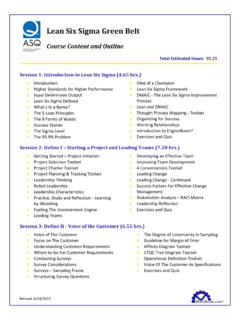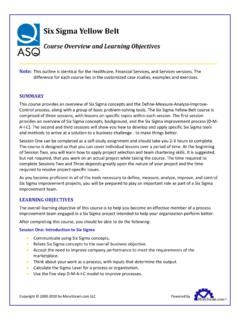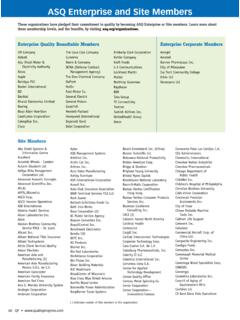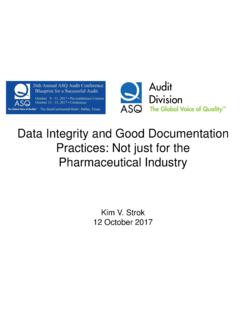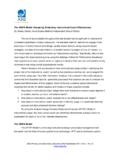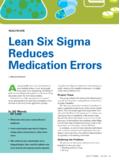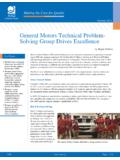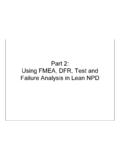Transcription of Certified Six Sigma Green Belt - ASQ
1 Certified Six Sigma Green BeltQuality excellence to enhance your career and boost your organization s bottom Six Sigma Green BeltCertification from ASQ is considered a mark of quality excellence in many industries. It helps you advance your career, and boosts your organization s bottom line through your mastery of quality skills. Becoming Certified as a Six Sigma Green belt confirms your commitment to quality and the positive impact it will have on your Six Sigma Green BeltExaminationEach certification candidate is required to pass a written examination that con-sists of multiple-choice questions that measure comprehension of the Body of Knowledge. The Six Sigma Green belt examination is a four-hour, 100-ques-tion exam. It is offered in the English language ExperienceSix Sigma Green Belts are employees who spend some of their time on pro-cess improvement teams. They analyze and solve quality problems, and are involved with Six Sigma , lean, or other quality improvement projects.
2 The Six Sigma Green belt certification requires three years of work experience in one or more areas of the Six Sigma Green belt Body of Knowledge. Work experience must be in a full-time, paid role. Paid intern, co-op, or any other course work cannot be applied toward the work expe-rience requirement. Educational waivers are not Expectations for a Certified Six Sigma Green belt Operates in support of or under the supervision of a Six Sigma Black belt Analyzes and solves quality problems Involved in quality improvement projects Participated in a project, but has not led a project Has at least three years of work experience Has ability to demonstrate knowledge of Six Sigma tools and processes The Six Sigma Green belt operates in support or under the supervision of a Six Sigma Black belt , analyzes and solves quality problems, and is involved in quality improvement projects. A Green belt has at least three years of work experience and wants to demonstrate his or her knowledge of Six Sigma tools and processes.
3 InformationFor comprehensive exam information on Six Sigma Green belt certification, visit Six Sigma Green Belt4 Certified Six Sigma Green BeltI Overview: Six Sigma and the Organization (15 Questions)A. Six Sigma and Organizational Goals 1. Value of Six Sigma Recognize why organizations use Six Sigma , how they apply its philosophy and goals, and the origins of Six Sigma (Juran, Deming, Shewhart, etc.). Describe how process inputs, outputs, and feedback impact the larger organization. (Understand) 2. Organizational drivers and metrics Recognize key drivers for business (profit, market share, customer satisfaction, efficiency, product differentiation) and how key metrics and scorecards are developed and impact the entire organization. (Understand) 3. Organizational goals and Six Sigma projects Describe the project selection process including knowing when to use Six Sigma improvement methodology (DMAIC) as opposed to other problem-solving tools, and confirm that the project supports and is linked to organizational goals.
4 (Understand)B. Lean Principles in the Organization 1. Lean concepts and tools Define and describe concepts such as value chain, flow, pull, perfection, etc., and tools commonly used to eliminate waste, including kaizen, 5S, error-proofing, value-stream mapping, etc. (Understand) 2. Value-added and non-value-added activities Identify waste in terms of excess inventory, space, test inspection, rework, transportation, storage, etc., and reduce cycle time to improve throughput. (Understand) 3. Theory of constraints Describe the theory of constraints. (Understand)C. Design for Six Sigma (DFSS) in the Organization 1. Quality function deployment (QFD) Describe how QFD fits into the overall DFSS process. (Understand) [Note: the application of QFD is covered in ]The topics included in this Body of Knowledge (BOK) are explanations (subtext) and cognitive levels for each topic or subtopic in the test. These details will be used by the Examination Development Committee as guidelines for writing test questions and are designed to help candidates prepare for the exam by identifying specific content within each topic that can be tested.
5 Except where specified, the subtext is not intended to limit the subject or be all-inclusive of what might be covered in an exam but rather is intended to clarify how topics are related to the role of the Certified Six Sigma Green belt (SSGB). The descriptor in parentheses at the end of each subtext entry refers to the highest cognitive level at which the topic will be tested. A complete description of cognitive levels is provided at the end of this document. Certified Six Sigma Green belt Body of Knowledge5 Certified Six Sigma Green belt 2. Design and process failure mode and effects analysis (DFMEA & PFMEA) Define and distinguish between design FMEA (DFMEA) and process (PFMEA) and interpret associated data. (Analyze) [Note: the application of FMEA is covered in ] 3. Road maps for DFSS Describe and distinguish between DMADV (define, measure, analyze, design, verify) and IDOV (identify, design, optimize, verify), and identify how they relate to DMAIC and how they help close the loop on improving the end product/process during the design (DFSS) phase.
6 (Understand)II Six Sigma Define (25 Questions)A. Process Management for Projects 1. Process elements Define and describe process components and boundaries. Recognize how processes cross various functional areas and the challenges that result for process improvement efforts. (Analyze) 2. Owners and stakeholders Identify process owners, internal and external customers, and other stakeholders in a project. (Apply) 3. Identify customers Identify and classify internal and external customers as applicable to a particular project, and show how projects impact customers. (Apply) 4. Collect customer data Use various methods to collect customer feedback ( , surveys, focus groups, interviews, observation) and identify the key elements that make these tools effective. Review survey questions to eliminate bias, vagueness, etc. (Apply) 5. Analyze customer data Use graphical, statistical, and qualitative tools to analyze customer feedback. (Analyze)6 Certified Six Sigma Green belt 6.
7 Translate customer requirements Assist in translating customer feedback into project goals and objectives, including critical to quality (CTQ) attributes and requirements statements. Use voice of the customer analysis tools such as quality function deployment (QFD) to translate customer requirements into performance measures. (Apply)B. Project Management Basics 1. Project charter and problem statement Define and describe elements of a project charter and develop a problem statement, including baseline and improvement goals. (Apply) 2. Project scope Assist with the development of project definition/scope using Pareto charts, process maps, etc. (Apply) 3. Project metrics Assist with the development of primary and consequential metrics ( , quality, cycle time, cost) and establish key project metrics that relate to the voice of the customer. (Apply) 4. Project planning tools Use project tools such as Gantt charts, critical path method (CPM), and program evaluation and review technique (PERT) charts, etc.
8 (Apply) 5. Project documentation Provide input and select the proper vehicle for presenting project documentation ( , spreadsheet output, storyboards, etc.) at phase reviews, management reviews, and other presentations. (Apply) 6. Project risk analysis Describe the purpose and benefit of project risk analysis, including resources, financials, impact on customers and other stakeholders, etc. (Understand) 7. Project closure Describe the objectives achieved and apply the lessons learned to identify additional opportunities. (Apply)7 Certified Six Sigma Green BeltC. Management and Planning Tools Define, select, and use 1) affinity diagrams, 2) interrelationship digraphs, 3) tree diagrams, 4) prioritization matrices, 5) matrix diagrams, 6) process decision program (PDPC) charts, and 7) activity network diagrams. (Apply)D. Business Results for Projects 1. Process performance Calculate process performance metrics such as defects per unit (DPU), rolled throughout yield (RTY), cost of poor quality (COPQ), defects per million opportunities (DPMO) Sigma levels and process capability indices.
9 Track process performance measures to drive project decisions. (Analyze) 2. Failure mode and effects analysis (FMEA) Define and describe failure mode and effects analysis (FMEA). Describe the purpose and use of scale criteria and calculate the risk priority number (RPN). (Analyze)E. Team Dynamics and Performance 1. Team stages and dynamics Define and describe the stages of team evolution, including forming, storming, norming, performing, adjourning, and recognition. Identify and help resolve negative dynamics such as overbearing, dominant, or reluctant participants, the unquestioned acceptance of opinions as facts, groupthink, feuding, floundering, the rush to accomplishment, attribution, discounts, plops, digressions, tangents, etc. (Understand) 2. Six Sigma and other team roles and responsibilities Describe and define the roles and responsibilities of participants on six Sigma and other teams, including black belt , master black belt , Green belt , champion, executive, coach, facilitator, team member, sponsor, process owner, etc.
10 (Apply) 3. Team tools Define and apply team tools such as brainstorming, nominal group technique, multi-voting, etc. (Apply) 4. Communication Use effective and appropriate communication techniques for different situations to overcome barriers to project success. (Apply)IIIISix Sigma Measure (30 Questions)A. Process Analysis and Documentation 1. Process modeling Develop and review process maps, written procedures, work instructions, flowcharts, etc. (Analyze) 2. Process inputs and outputs Identify process input variables and process output variables (SIPOC), and document their relationships through cause and effect diagrams, relational matrices, etc. (Analyze)8 Certified Six Sigma Green BeltB. Probability and Statistics 1. Drawing valid statistical conclusions Distinguish between enumerative (descriptive) and analytical (inferential) studies, and distinguish between a population parameter and a sample statistic. (Apply) 2. Central limit theorem and sampling distribution of the mean Define the central limit theorem and describe its significance in the application of inferential statistics for confidence intervals, control charts, etc.
